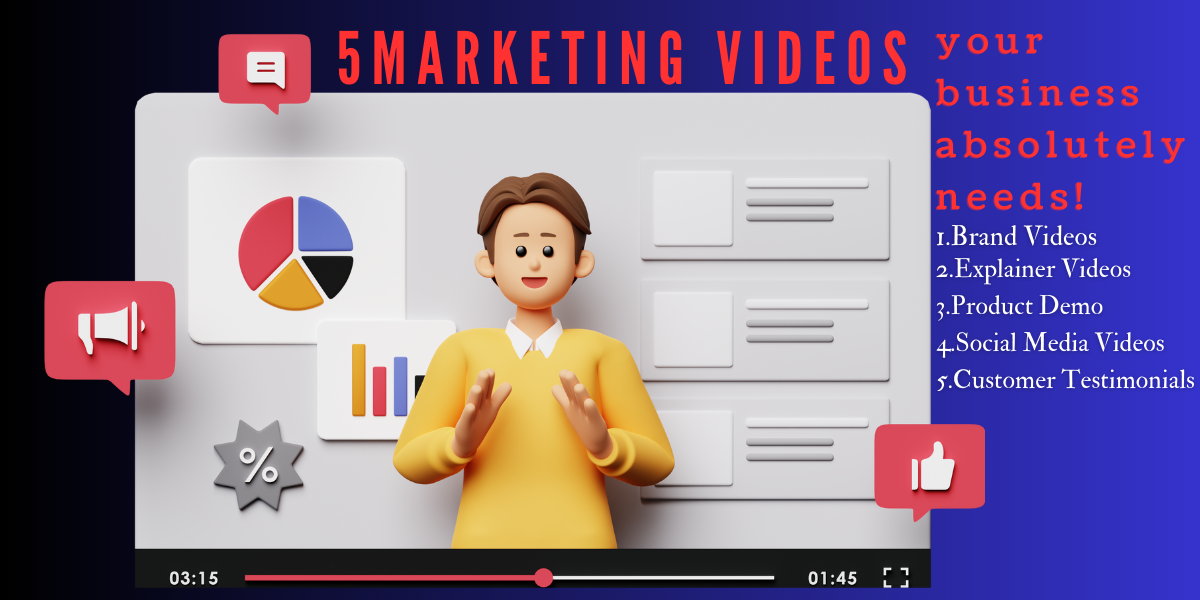
11 Key Factors While Editing Content Targeting Seniors
11 Key Factors While Editing Content Targeting Seniors Editing content requires careful attention to detail and a systematic approach to ensure clarity, coherence, and accuracy.
Unleash the Power of Visual Storytelling

Are you losing customers to noise?
Imagine the business landscape as a crowded marketplace, bustling with competitors vying for the attention of customers. In this noisy world, how can your business break through the clutter and captivate your target audience? The answer lies in the art of visual storytelling through product marketing videos.
1) There are 5 critical product marketing videos your business absolutely needs – right now.
2) Explainer Videos – Explainer videos are a powerful tool in your product marketing video arsenal to introduce your products or services in a concise and engaging manner.
3) Product Demonstration Videos – Unlike an explainer video which tells you about a product/service, a product demonstration video shows you the product/service.
4) Testimonial Videos – Testimonial videos are powerful social proof that can significantly influence potential customers’ purchasing decisions.
5) Brand Storytelling Videos – Brand storytelling videos enable you to connect with your audience on an emotional level, sharing the narrative behind your brand’s mission, values, and journey.
6) Social Media Videos – In the era of social media dominance, short and engaging videos optimized for various platforms are crucial for promoting your business.
In an ever-evolving digital era, with dwindling attention spans and information overload, businesses that fail to harness the power of product marketing videos risk being left behind, watching potential customers slip through their fingers. Product marketing videos are now the secret weapon for successful companies, helping them convey their brand messages, showcase their products, and build authentic connections with their audience.
In this article, we unveil the five types of product marketing videos your business simply cannot afford to overlook. We will explore each of these product marketing videos, examining their significance and the potential they hold for your business. From captivating explainer videos that simplify complex solutions to awe-inspiring product demonstrations that showcase the value you offer, these videos act as your brand’s ambassadors, reaching out to customers and speaking directly to their needs.
Moreover, we will delve into the power of testimonial videos, where satisfied customers become your advocates, sharing their genuine experiences and driving conversions. We will also uncover the impact of brand storytelling videos, weaving narratives that resonate deeply with your audience, creating an emotional bond and differentiating your brand from the competition.
Lastly, we explore the effectiveness of social media videos, designed to capture attention in the blink of an eye and amplify your reach across platforms. Failing to embrace these videos means leaving opportunities untapped and losing out on potential customers who are craving engaging, visually captivating content.
Harnessing the power of visual storytelling, these product marketing videos serve as catalysts to propel your business forward. They possess the unique ability to deliver concise, compelling narratives, and ignite curiosity within your target audience. By evoking emotion, demonstrating functionality, and presenting your products in an immersive way, these videos bring your brand to life and cultivate a sense of urgency in the minds of viewers.
In a world where attention is scarce and competition fierce, the urgency to create these five essential product marketing videos cannot be overstated. By embracing visual storytelling and incorporating these videos into your marketing strategy, you will ignite the curiosity of your audience, build trust, and establish a compelling brand presence that propels your business to new heights.
So, join us on this transformative journey as we unlock the potential of product marketing videos and unleash the power of visual storytelling to secure your business’s success in a rapidly evolving digital landscape. Failure to do so risks losing ground to competitors who have already tapped into the immense potential of these engaging and persuasive videos. The time to act is now.
To effectively promote their products and business, there are five essential types of videos that every business should consider incorporating into their marketing strategy:
Explainer videos are a powerful tool in your product marketing video arsenal to introduce your products or services in a concise and engaging manner.
Explainer videos are short animated or live-action pieces that explain your business idea. They’re both informative and entertaining, using compelling storytelling, and fun animations and characters that illustrate your message in a clear and captivating way. Moreover, since they’re typically less than 2 minutes long, explainers are really simple and straightforward.
Explainer videos are more effective early in the marketing funnel – they explain what you do to people who either haven’t heard of you at all, or who don’t know much about you yet. These videos provide an overview of how your offerings solve a specific problem or meet a particular need. By breaking down complex concepts into easily understandable visuals and narratives, explainer videos help potential customers grasp the value and benefits of your offerings quickly.
Because they’re so short, they’re perfect for catching your audience’s attention quickly. They are also great at educating prospects about your business and selling your products or services, all while generating brand awareness through the use of your characteristic brand colors and tone.
To keep it interesting, experts recommend keeping the explainer’s length between the 60 and 90-second mark. Don’t forget to mention what product or service you offer, how it can help your clients with their pain points, and why it’s better than the competition. Needless to say, use your logo & brand colors consistently. Eventually you want to connect & reinforce the values / benefits shown in the explainer with your brand.
Experts provide businesses these 10 best practices when creating explainer videos as part of the product marketing video stack.
1. Be clear. You only have a few seconds to get your message across. So be clear & be concise. This is what you do. This is the problem you solve. This is why you’re different.
2. Tell them a story. Keep it interesting. Use a hook at the beginning (a challenge, an emergency or a pain point). Lead it up with the journey & then the final climax. For someone to stick around long enough to receive your message, you need to keep it entertaining, which means using narrative, intrigue and emotion.
3. Keep it brief. You don’t want to bore your viewers. Your viewers may be new to you, so don’t expect to hold their attention for 10 minutes first time around. Aim for 90 seconds or ideally less, depending on the channel.
Here is an example of a well made explainer made memorable with humor.
Dollar Shave Club
This is perhaps one of the iconic top explainer videos that perfectly demonstrates that the idea behind the video is always important. Every second of the video keeps us engaged: the visuals (very simple, yet extremely realistic) support the idea, the main character reminds us of an old friend, and the sounds support the story during the whole video. Again, this is another video that uses humor to deliver the idea.
A subsection of explainer videos are what we call ‘Educational Videos’. As per a recent survey, they come in second to Product Demo Videos in terms of viewership, engagement & ROI.
In this type of small business video, you teach your audience about a certain topic or how to solve a problem related to your products and services. A good educational video for your business should be informative and entertaining. Because it’s that, it is a great way to provide valuable content to your target market. A perfect product marketing video.
A good educational video is great to lead your prospects from the ‘Awareness’ stage to a ‘Consideration’ or ‘Demand’ stage. It’s a great video if you see it being shared by your target audience. As they are supposed to be informative rather than sell something, focus on being helpful & answering questions you think they might have.
PandaDoc’s product marketing video does just that. Using animation, it takes the viewer through the pain points & the features that provide the solution to those problems. It is concise, yet educates and guides the prospect to consider Pandadoc as a solution for their sales process.
Which brings us to Product Demonstration Videos.
Unlike an explainer video which tells you about a product/service, a product demonstration video shows you the product/service.
Product demonstration videos allow you to showcase the features, functionality, and benefits of your products in action. These videos provide a visual representation of how your products work and how they can enhance the lives of your customers. By highlighting the unique selling points and demonstrating the value they bring, product demonstration videos build trust, drive engagement, and increase the likelihood of conversions.
Your focus here is on showing your product in detail, instead of just a simple explanation of what it does. Highlight all its features and benefits – after all it’s the star of the show! This is the time to sell. Tell your audience exactly why you are the best option out there and how your product can solve their needs better than any other.
These product marketing videos for business are useful in eCommerce since they’re the next best thing to physically interacting with a product. They work especially well for SaaS based products – walking users through their innovative features and how to use them. We have seen them being used to good effect in demonstrating physical products too – such as medical devices. Compliance & regulatory solutions that are productised also can benefit from this format. A great business product demo video is one that helps prospects finally make that purchase decision. You can really pull out the marketing tactics here, getting as simple or as technical as you want and going over what you’re offering in detail.
Based on past client interactions, prepare a list of FAQs in advance. Tackle any questions your viewers may have before they even ask them, and have the answers ready. Think about the best format to convey & easily explain your product’s features: perhaps a voiceover explaining them, or just some blurbs of text? And, if it’s needed, don’t be afraid to create a longer video so you can really show the audience all the potential benefits. Now if you really want to make a mark, do have a look at these 10 best practices created by the experts on product marketing.
1. Plan. Plan. Plan. – Write down the script in advance. If you have a lot of key selling points to cram in, each shot should deliver on at least one, possibly more. Plan your flow with the key messages & call to action (CTA) you want to focus on. A/B testing helps.
2. Be relatable. – Aligning with your target segment is critical. Seeing ‘someone like me’ using the product makes it much easier to visualize using it myself. For example, you don’t (necessarily) want a basketball player talking through the intricacies of a medical device. It would create more veritas (& trust) if it was being delivered by a physician.
3. Make it exciting -The ultimate product demo videos are shareable, because they get people enthusiastic about your product. You may not be Apple launching the latest iPhone, but there’s no reason you can’t create a buzz around your product.
Product videos are more effective further down the marketing funnel – they are for people who are actively considering a purchase, who want to know more about the product. Typically these would follow ‘Educational videos’ we talked about earlier.
Simply put, an explainer video is like a billboard with say Michael Jordan showing off the new Nike trainers, while a product video is more like going to the shop to try one on.
Here are a few examples of Product demonstration videos.
Microsoft is one of the biggest brands in the world, but even with their legacy they still need effective messaging. This is another concise video that B2B players will want to emulate. It’s highly effective at educating the viewer on Microsoft’s enterprise cloud solution.
At nearly two minutes long, this product demo packs a powerful punch with visuals of SurveyMonkey’s benefits and features as well as a walk-through of the product interface.
Testimonial videos are powerful social proof that can significantly influence potential customers’ purchasing decisions.
These videos feature satisfied customers sharing their positive experiences, outcomes, and satisfaction with your products or services. In a testimonial video, a past client tells viewers about their positive experience working with you and explains how you helped them with their pain points. It’s structured like a story, with a beginning (explaining what problems your client had and how they found you), a middle (discussing why they chose you), and an end (talking about the results and what the experience was like).
Testimonials provide authentic and relatable feedback, reinforcing trust in your brand and building credibility. They demonstrate the real-world impact your offerings have had on customers, helping prospects make informed decisions.
Testimonial videos is the go-to for any prospective customer who needs reassurance before finally choosing your business over the competition. A testimonial gives a first-person account of what it’s like to work with you, providing a much-needed human touch to the purchasing process. Testimonial videos are generally used to create third party validation from industry peers & colleagues, helping users take a decision to either consider the product or make that purchase.
Make it look and feel as natural as possible. If it sounds too scripted, your viewers won’t believe what they’re hearing, even if it’s true. Our recommendation? Let them tell their story in their own words! People like authenticity. Additionally, try to shoot some scenes at their workspace, with colleagues if possible, to give a feeling of authenticity to the video.
Worst case scenario: Often people are not comfortable being in front of the camera. A couple of workarounds
i) Get them over a ZOOM / Teams call & do a freewheeling interview covering the areas you want to capture. Then edit the video to share segments you want to highlight.
ii) People don’t always expect to see testimonial videos in cinemascope. You will be surprised to find that clients too are ok with shooting selfies / videos on their handy iPhone. In fact videos shot on iPhone, in natural environments create a better sense of authenticity – feeling less scripted to the viewer.
Here are some easy yet detailed guidelines we put together for creating great testimonial videos for your product marketing mix.
Some examples we found interesting.
Freshbook, the accounting software company used a practical approach while creating its Testimonial video. The video shows a customer explaining how the product took care of her accounts so she could focus on her core business.
Takeaway: Simple and crisp video testimonials exude honesty and are thus a huge hit.
Codeacademy is an online interactive platform that offers free coding classes. This testimonial is short and sweet. In fact, it’s almost like a cross between a teaser video and a testimonial – it gives viewers just enough information to inspire them and make them want to find out more.
Short testimonials like this are great if you lack the budget or time to create a longer video that features lots of different clients. Instead of focusing on the ins and outs of your product or service, you can go for a more conceptual approach and ask clients how it made them feel and why they enjoy using it.
Brand storytelling videos enable you to connect with your audience on an emotional level, sharing the narrative behind your brand’s mission, values, and journey.
In a nutshell, brand videos help introduce your brands. They are best when designed to build awareness around your business to attract potential customers. This is true whether you’re telling people how to use your product, describing pain points your products solve, or simply building rapport with fun branded content.
Brand videos evoke empathy, create a sense of authenticity, and foster a deeper connection between your business and your target audience. They are also your way of communicating what your values are – and answering why your brand exists. By weaving a compelling story that resonates with viewers, brand storytelling videos humanize your brand and help differentiate you from competitors.
Simply put, brand videos allow you to provide an ideal first impression for potential customers. Be it website visitors, social media followers, email subscribers or even investors. And first impressions are very influential when its time to buy.
In addition, brand videos allow you to differentiate your brand from your competitors. It allows you to express your personality, and discuss how your product is different or better than the alternatives. When done right they compel viewers to engage through your call to action at the end.
1) Define your brand story: Clarify your brand’s unique story, including its origins, values, mission, and vision. Identify the key elements that differentiate your brand and make it compelling. This foundation will serve as the backbone of your storytelling videos.
2) Understand your audience: Create your ICP (Ideal Customer Profile). Build your customer persona by gain a deep understanding of your target audience’s demographics, interests, and values. Tailor your brand storytelling videos to resonate with their emotions, aspirations, and needs. Craft narratives that align with their desires and create a sense of connection.
3) Utilize compelling visuals: Visuals play a significant role in brand storytelling videos. Use high-quality imagery, video footage, animations, or graphics that align with your brand’s aesthetics and evoke the desired emotions. Visuals should enhance and support the narrative.
A great brand profile video is one of the key videos you should think of creating as part of your product marketing video strategy. It might seem daunting, but it’s not difficult to create, even if you are a small or medium sized business.
Our research has thrown up these guidelines used by successful organizations & advertising agencies to create exceptional brand videos.
Patagonia, an outdoor clothing designer, is true to its mission of saving the planet long before it was fashionable to do so. It’s brand video mirrors that idea, reinforcing it in its messaging.
Dissolve created a viral brand video that’s both irreverent, but spot on. Subtly referencing its products, people, diversity & global reach. This might not work (generally) in formal settings like healthcare, but can be used to great effect as a clutter breaker. It’s an example of a worthy brand campaign as part of their product marketing videos.
We had to share this example. This is a well crafted brand video by BARK, that stays on the brand message, walking the viewer (no pun intended) through the company profile and its services. Not only is it engaging, but it clearly demonstrates that a good brand video isn’t just the purview of big firms.
In the era of social media dominance, short and engaging videos optimized for various platforms are crucial for promoting your business.
Unlike the other formats we talked about, these videos are specifically created with social media in mind. Social media videos can take various forms, including teaser videos, behind-the-scenes footage, user-generated content, influencer collaborations, or quick tips and tutorials. These videos leverage the power of social platforms to reach a broader audience, increase brand awareness, and encourage sharing and engagement.
They have two key features: they’re short, and they need to capture the viewer’s attention right away. And why is that? Because social media is fleeting in nature, so in order to catch the average user’s eye, and keep them hooked until the end, a social media video has to be brief and captivating.
In today’s interconnected and always on world, having a strong social media presence is paramount for any small business, and video can be very helpful to that objective. They are also great for increasing engagement and followers on your social pages. Moreover, because of the wide reach most platforms have, social videos can be a cost-effective way to generate brand awareness.
TikTok, Instagram, Reels – whichever platform you choose, create your videos in the format it’s most suited for. It’s crucial you shoot your video in portrait orientation, with an aspect ratio of 9:16, so it can fit on mobile screens. You should also do some research on what’s your audience’s preferred platform, so you can tailor your video to it and stay on top of new trends for future pieces. Once you’ve uploaded it, be sure to check its metrics so you know what your followers like best. Keep your audience in mind when creating your videos. While B2C firms tend to use TikTok, Instagram & Reels, B2B firms find greater success on LinkedIn & Twitter. YouTube is still the goto platform if you are looking to create longform videos. Here is a quick step by step walkthrough to create impactful social media videos for your basket of product marketing videos.
Remember, visibility & hence distribution is key. Even as a small or medium business with limited resources, social media videos can be a great way of creating brand & product awareness. Not only can you repurpose your videos, but you can also save time. Create a video & post it on all the different social channels with just a few clicks.
The Oreo and Game of Thrones sequence video is one of the amazing examples of how animation can be used effectively for social media marketing. It generated a lot of buzz on social media due to its clever use of popular culture references.
The combination made the video relatable and shareable, as fans could relate to the emotions and experiences depicted in the video.
The Dove Project #ShowUs is a body-positive campaign that challenges society’s beauty standards and celebrates diversity. It taps into the zeitgeist of body positivity and inclusivity, resonating with consumers. As a social media post this is timely and socially relevant. By promoting a message of empowerment and inclusivity, Dove has positioned itself as a socially responsible brand using social media channels to spark conversation, positioning itself to diversity & inclusion that consumers can relate to and support.
By incorporating these five essential product marketing video types into your marketing strategy, you can effectively promote your products and business. Each type serves a specific purpose in capturing attention, explaining, demonstrating, building credibility, and forging connections. Remember to tailor the content, tone, and style of your videos to align with your target audience and business objectives. With a thoughtful and strategic approach to video marketing, you can drive engagement, conversions, and long-term business growth
References:
a) Wikipedia.com
b) Hubspot.com
c) Yumyumvideos.com
d) Woshii.com
e) Nealschaffer.com
f) Wistia.com
g) Looka.com
h) Wyzowl.com

11 Key Factors While Editing Content Targeting Seniors Editing content requires careful attention to detail and a systematic approach to ensure clarity, coherence, and accuracy.

How To Write A Great Explainer Video Script For Seniors Learn how to craft a great explainer video script to sell senior focused products &

How To Make Videos For Social Media To Promote Your Business Alright, folks, let’s dive into the world of social media wizardry! If you’re eager